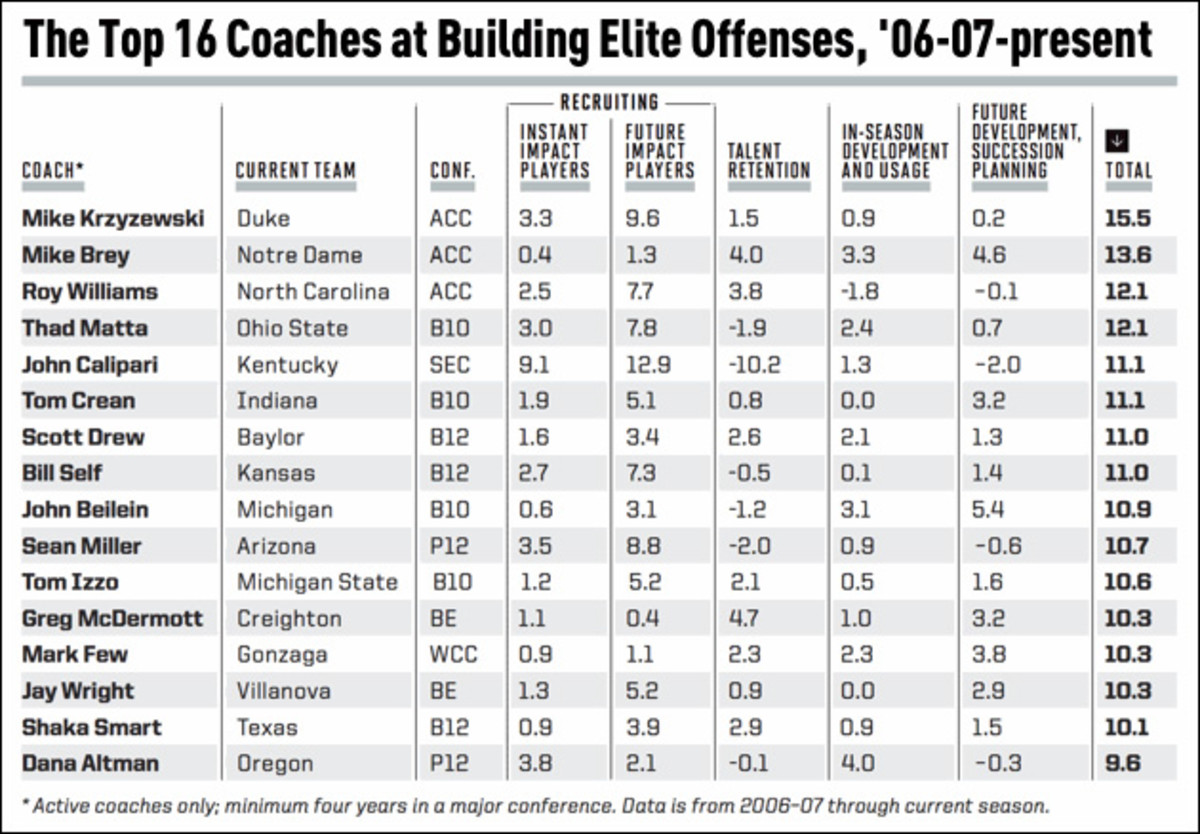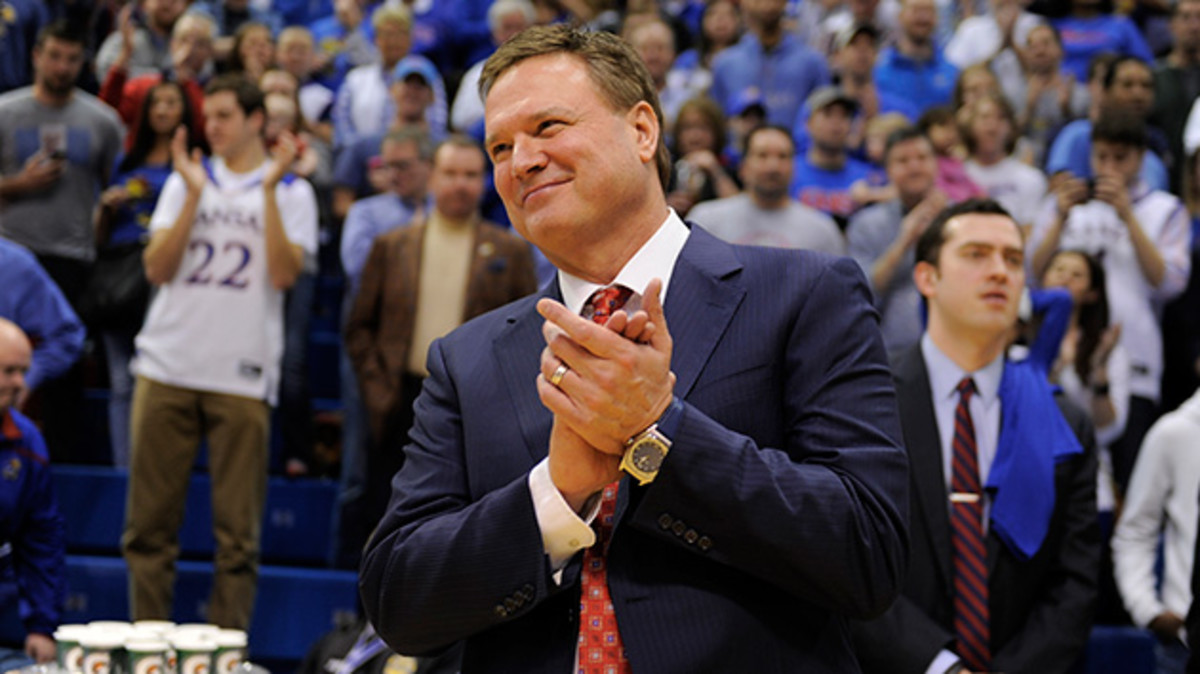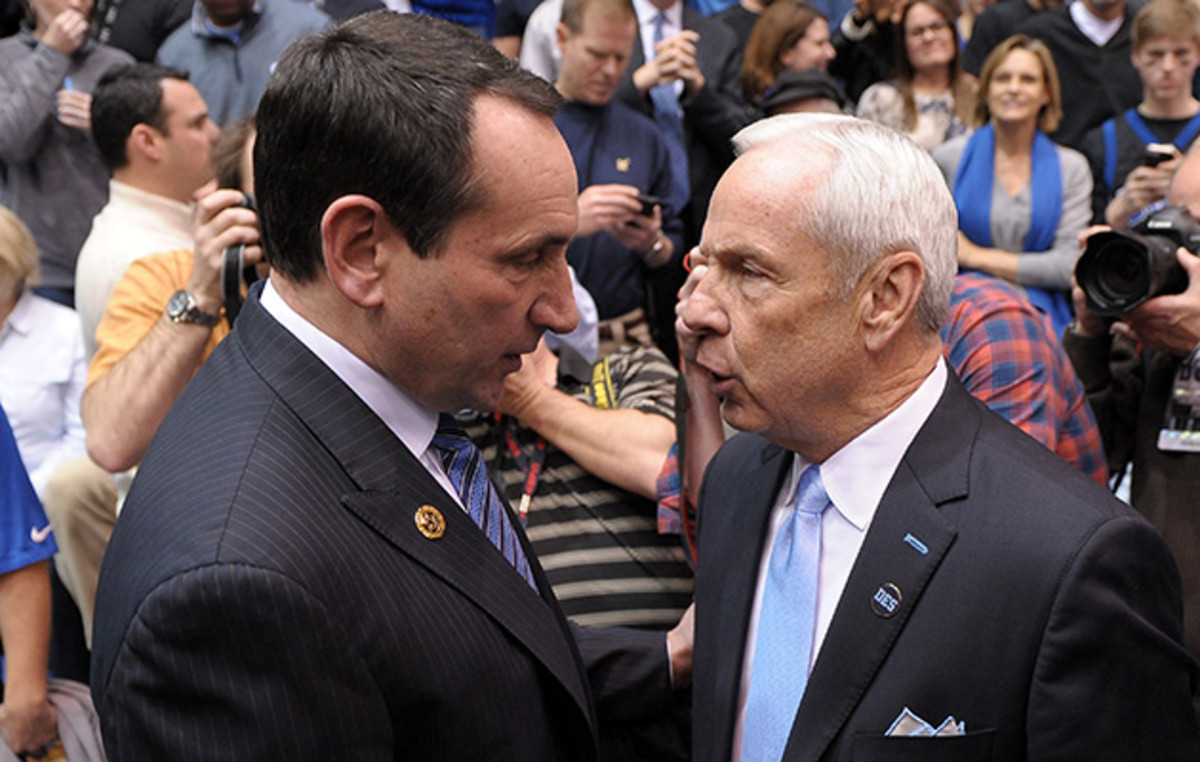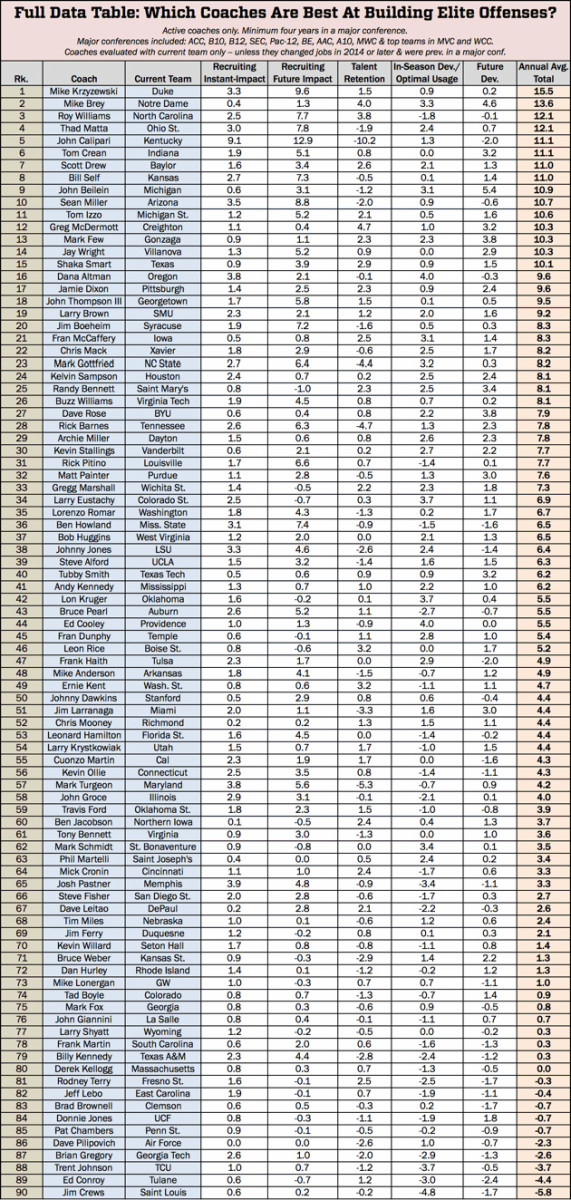SI study: Which coaches are the best at building elite offenses?

In the one-and-done era, coaches who recruit the most NBA-ready prospects have the best shot at the Final Four, right? Not necessarily. Subscribe now for in-depth coverage, only from Sports Illustrated. This story originally appeared in the March 21, 2016, issue.
When >Sports Illustrated set out to quantify which coaches are the best at building elite offenses, the first step was to model a fictional team. The Middling Tennessee State Wildcats will never appear in an NCAA tournament bracket; they’re the equivalent of the “replacement-level” concept that guides major league baseball’s WAR analytics: a squad of three-star recruits whose careers develop at an average rate. We relied on the decade-plus of player data we’ve collected for the College Basketball Projection System that has guided our preseason forecasts for each of the past two seasons. We then placed values on what coaches do to outperform Middling Tennessee State, in terms of points per 100 possessions, and ranked coaches by their average contribution above (or below) that baseline over the last 10 seasons.
We operated under a theory that there are five quantifiable components of college offense building.
1. Recruiting for Instant Impact: Bringing in freshmen or transfers talented enough to boost the offense in Year 1.
2. Recruiting for the Future: Players who will make their biggest impact in Years 2, 3 and 4.
3. Talent Retention: Having valuable players put the NBA draft on hold longer than expected—and avoiding transfers.
4. In-Season Development and Optimal Deployment: Having players exceed their projected performance (based on past stats and recruiting rankings) on a year-to-year basis, and structuring an offense so that the best players take the most shots.
5. Future Development and Succession Planning: Using rotation spots to groom younger (and often underrated) players who will remain at the school and assume bigger roles following key departures.
*****

SI’s study was limited to coaches who’ve spent at least the past four years in one of the nine biggest conferences (the ACC, American, Atlantic 10, Big East, Big Ten, Big 12, Mountain West, Pac-12 and SEC) or at one of the elite programs in the Missouri Valley or West Coast Conferences. It begins with data from 2006–07 and ends with the 2015–16 regular season, up until the beginning of conference tournaments. It focuses strictly on offense because it’s possible to analyze players on an individual level (not so with defense), and because great offense is critical in the NCAA tournament. Just one national champ in the past 10 years (UConn in 2014) has entered the dance ranked outside the top 20 in adjusted offensive efficiency.
The No. 1 coach in our study, Duke’s Mike Krzyzewski, has signed more McDonald’s All-Americans in this span than many teams have in the 39 years the fast-food honor has existed—but he’s also excelled at adapting his offense to let that talent thrive and not restrict its development. SI values Krzyzewski’s average annual contribution at +15.5 points per 100 possessions. (You can see the full ranking of coaches at the bottom of this story.)
Coach K’s offensive empire has been built on two starkly different approaches. From 2006–07 through ‘13–14, Krzyzewski’s profile almost mirrored that of his closest rival, North Carolina’s Roy Williams. The Blue Devils’ coach generated most of his offensive value from Recruiting for the Future and Talent Retention. But in 2014–15 and ‘15–16, Krzyzewski’s offensive profile looked a lot more like that of Kentucky’s John Calipari. Coach K 2.0 is based on the combination of instant and future recruiting impact—enough to counteract increased early departures—and his success is further boosted by how much the Blue Devils outplayed their projected development curves. The new process is recruit, fast track to stardom, reload.

Duke assistant coach Jon Scheyer is a bridge between the two eras. Scheyer was a senior point guard on Duke’s 2009–10 national championship team, which ranked No. 1 in offensive efficiency and had a starting lineup of upperclassmen who all made their biggest impacts later in their careers. In Scheyer’s two seasons as a full-time assistant, he’s coached a national-title team led by one-and-done freshmen Jahlil Okafor, Tyus Jones and Justise Winslow, and now a squad with a seven-man rotation that includes four freshmen, the headliner being likely one-and-done star Brandon Ingram.
“It’s a different time from when I played,” Scheyer says—even though that was just six years ago. “These guys the last few years—Jabari [Parker], Jahlil, Justise, Brandon—have come in so ready as freshmen. When I was coming in, there was still a little bit of second-guessing—can you play well at this level right away?—but for them they know. The physical maturity and self-confidence with these guys is just different.”
Krzyzewski’s Blue Devils ranked No. 3 in adjusted offensive efficiency last season on kenpom.com, are No. 6 this season, and have a monster 2016 recruiting class that includes the offensively skilled Jayson Tatum (the nation’s No. 1 small forward recruit), Harry Giles III (the No. 1 power forward) and guard Frank Jackson (a top 15 prospect). Combine their expected Year 1 value with the projections for Duke’s returnees, and you have the makings of another offensive juggernaut.

1 and 2. The value of recruiting, now and for the future (if you know what to do with all that talent)
How does SI place expected values on recruits? By using more than a decade of data on players who had similar recruiting rankings and creating an aggregate profile of their college production, year-to-year development and how long they remained in school. And while instant-impact recruiting can yield big results with the right coach—Calipari adds a yearly average of +9.1 points per 100 possessions to his offenses this way—it’s not a guarantee of success. Cases in point: The Nos. 2 and 3 coaches over the past decade at Recruiting for Instant Impact are Dave Rice (+4.7 P/100P) and Josh Pastner (+3.9). Rice, who was fired by UNLV on Jan. 10, had the study’s lowest player development-and-deployment rating (-4.8) and its third-lowest talent-retention rating (-5.2), completely negating his recruiting value. Pastner, who had the study’s fourth-lowest development-and-deployment rating (-3.4), is under fire at Memphis after going 8–10 in the AAC this season.
SI experts pick their 2016 NCAA tournament brackets
What we call Recruiting for the Future—adding players who fall just below the one-and-done profile and make impacts in Years 2, 3 and 4—tends to be the most valuable aspect of offense building. Prospects ranked outside the Recruiting Services Consensus Index’s (RSCI) top 30 typically provide more value later in their careers than they do in Year 1, and no coach has capitalized more this season on the increasing returns of second-tier recruits than Kansas’s Bill Self, who ranks No. 8 overall in SI’s study.
Self’s 2015–16 Jayhawks are No. 8 in adjusted offensive efficiency using a starting lineup that includes senior power forward Perry Ellis (the No. 31–ranked recruit in the 2012 RSCI), junior point guard Frank Mason (No. 89 in 2013) and sophomore guard Devonte’ Graham (No. 65 in 2014), and junior center Landen Lucas (who was not in the top 100). The instant-impact value SI projected KU to get out of potential one-and-done forward Cheick Diallo (No. 6 in 2015) hasn’t materialized in the way it did for recent KU freshmen Andrew Wiggins or Joel Embiid, and the Jayhawks won the Big 12 on the strength of their veteran core.
“In the case of this team,” Self says, “our assistant coaches did a really good job evaluating guys who may not have been in the top 25 [of the recruiting rankings] but had a chance to play at that level over time. Now, I want the best players regardless, so if I have the chance to get five top 10 recruits, I want that. That gives us a great chance to win that year, and gives us a great chance to recruit based on all those guys’ success. But there’s more than one way to do it. If you look at us, we’ve been pretty consistent in having a blend of youth and experience. In a perfect world your best players would be your freshmen, and your foundation would be your juniors and seniors—but this one particular year, we’ve got more experience than youth.”
With a much lower volume of high-impact freshmen on the college scene this season than there was in 2013–14 or ‘14–15, this is a fortuitous time for Self to have a veteran stockpile. “We’ve started probably as many freshmen recently as any team other than Kentucky,” he says, “so this is a rare situation for us.... The last time we had this many experienced, major contributors was in 2012, and we got to the [national title game]. It really did pay off.”

3. The power of staying (and why ol’ Roy rages against the green-rooming of college hoops)
Wisconsin’s appearance in the 2015 national-title game was the greatest advertisement for the third component of elite offense building: Talent Retention. SI’s model forecasts players’ expected number of college seasons, initially basing that figure on recruiting profiles, and in the following years blending in players’ college performances. Keeping two stars who had realistic NBA draft opportunities (Frank Kaminsky and Sam Dekker) and not having any critical players transfer in the course of building that ‘14–15 team put Badgers coach Bo Ryan well above the baseline in talent retention. Before he retired on Dec. 15, Ryan ranked as a top 10 offense builder by using a unique formula: He developed recruits who at first had little projected value, and then derived the second-most value of any coach (an average of +4.6 points per 100 possessions) by continuing to groom those now valuable players in his program.
This NCAA tournament’s best example of the Power of Staying could be North Carolina, whose coach, Roy Williams, has the highest talent-retention rating this season (+5.3 P/100P), due to keeping potential early draft entrants Justin Jackson, Brice Johnson, Kennedy Meeks and Marcus Paige in Chapel Hill. This type of team is quintessential Williams: He won both of his national titles at UNC with rosters built around upperclassmen, and he has the third-highest talent-retention rating over the entire study (+3.8 P/100P). It was no surprise, then, that his greatest press-conference rant of the season—and really, the Rant of the Year by any coach—was inspired by disgust for ESPN’s focusing its college basketball broadcasts on promoting Green Room Guys at the expense of, in Williams’s words, “saying college basketball means something.”

As Ol’ Roy put it on Jan. 29, according to Raleigh’s News & Observer: “... I’ve got to watch on TV where somebody’s [calling a] college basketball game and they’re talking about the freaking green room? That’s the most ridiculous thing ... That’s half the damn broadcast: ‘Well, so-and-so’s in the green room.’
“And this is a great time for me to be saying something about it. Because they ain’t mentioning any of my guys, O.K. But God almighty, you’re sitting there, you’re trying to win championships and here it is, January, and ESPN’s talking about some green room ... That’s the most ridiculous thing we’re having to put up with in college basketball.”
• MORE: Breaking down each region of the bracket
Williams has not had to put up with many Tar Heels leaving earlier than projected. He has either missed out on or avoided recruiting from the recent one-and-done pool and is on a campus where players are neither hasty about the draft nor itching to transfer. Paige, the senior point guard who is on the verge of two BAs (in history and journalism), believes that UNC’s talent retention was more self-reinforcing than coach-reinforcing: “I don’t think Williams gets people to stay, I think they choose to stay despite having opportunities to leave,” he says. “Being at North Carolina isn’t the worst thing in the world.”
4. In-season development and optimal deployment (aka the coaching part of coaching)

This is where basketball instruction and game strategy is factored into the study, by measuring two things: how much a coach’s players outpace SI’s preseason efficiency projections on a year-to-year basis—aka “offensive development”—and how well a coach maximizes the impact of his best players by putting them in position to take the most shots (chart, right).
Non-dominant recruiters can make up ground by excelling at development and deployment, and there have been few coaches better at this than Oklahoma’s Lon Kruger. He generated the third-highest average value in this category (+3.7 P/100P) and has one of the nation’s scariest offenses, despite not having a single top 100 recruit on his roster. Kruger’s players have continued to make leaps in efficiency late into their careers. By refining Jordan Woodard’s shooting stroke and moving him from the point to off the ball, Oklahoma’s coaches helped boost him from a 99.7 Offensive Rating as a sophomore to a 116.2 as a junior. Buddy Hield was an inaccurate long-range shooter and marginally efficient scorer for his first two seasons in Norman; now, the senior is among the most efficient, high-volume scorers in the country (46.4% from three), and is regarded as the co-front-runner (along with Michigan State’s Denzel Valentine, page 48) for the Naismith and Wooden awards.
Inside The Rating System
How Tom Izzo's 2015–16 contribution is measured
SI's study ranked coaches by their 10-season average contribution to building elite offense, but what are the components of a single-season rating? Michigan State's Tom Izzo ranked second among all coaches (behind only Notre Dame's Mike Brey) for his 2015-16 contribution, adding +17.4 points per 100 possessions over the baseline. Here's the timeline of events that added up to Izzo's current-season contribution:
• Summer 2012: Gary Harris (RSCI Rank: 17), Matt Costello (87), and Denzel Valentine (89) enrolled. Future Impact Recruiting = +2.2
• 2012-13 Season: Harris became a star, making him unlikely to stay until '15-16. Costello barely played. Valentine was inefficient. Net effect of Future Development = 0.0
• Spring 2013: No unexpected NBA or transfer decisions impacting 2016. Talent Retention = 0.0
• Summer 2013: Kenny Kaminski (RSCI: 98) became active after a medical redshirt. Unranked recruits Gavin Schilling and Alvin Ellis enrolled. Future Impact Recruiting = +0.4
• 2013-14 Season: Valentine became an efficient starter. Costello and Kaminsky became efficient reserves. Future Development = +1.8
• Spring 2014: Harris made his expected draft declaration. Kaminski transferred. Talent Retention = -0.8
• Summer 2014: Transfer Bryn Forbes became eligible. Recruits Lourawls Nairn (RSCI: 78), Javon Bess and Marvin Clark enrolled. Future Impact Recruiting = +1.7
• 2014-15 Season: Valentine became a star. Forbes became an efficient role player. Costello and Schilling became reliable frontcourt players. Nairn significantly underperformed projections. Future Development = +3.0
• Spring 2015: Valentine stayed in school, but there were low odds of him leaving, so the bonus here is low. Talent Retention = +0.7
• Summer 2015: Transfer Eron Harris became eligible. Recruits Deyonta Davis (RSCI: 26), Matt McQuaid (67) and Kyle Ahrens enrolled. Michigan State's crowded frontcourt limited immediate expectations for Davis. Instant Impact Recruiting = +2.1
• 2015-16 Season: Valentine became a NPOY candidate. Forbes became a ~50% three-point shooter. Every other rotation player (most notably Nairn) became more efficient. In-Season Development & Optimal Usage = +6.3
• Total: +17.4 points per 100 possessions above the baseline
“We work with shooters here,” Kruger says. “When we talk recruiting profile, we love high motors, guys with great energy who if they can’t already shoot it, can develop into it. But if we don’t think a perimeter [recruit] can become a decent shooter, then we probably don’t recruit him for long.”
Kruger is also savvy about using his best players in the biggest roles. Hield’s possession usage has gone up as he’s refined his shot accuracy, and he and the Sooners’ other two starting guards—Woodard and Isaiah Cousins—have accounted for 61.8% of the team’s shots this season.
The only two coaches who top Kruger in this category are Providence’s Ed Cooley and Oregon’s Dana Altman (both at +4.0 P/100P). Cooley has a strong track record for developing under-the-radar prospects into stars; he did it with unrated point guard Bryce Cotton from 2010–11 through ‘13–14, with three-star wing La-Dontae Henton from ‘10–11 through ‘14–15, and currently with sophomore power forward Ben Bentil, whose RSCI rank was 91 before his senior year of high school.
This season at Oregon, Altman built the nation’s No. 5 offense in adjusted efficiency—and the Pac-12’s regular season and tournament champs—by maximizing the value of underrated Canadians. Montreal-raised elastic-man/power forward Chris Boucher was a coveted juco transfer out of Northwest College in Wyoming, but in his first year in the Ducks’ system he has far surpassed the typical production for an elite juco product, posting the third highest offensive rating in Pac-12 play (134.6). Dillon Brooks, from Mississauga, Ontario, was a four-star recruit but didn’t rank in the class of 2014’s top 100. By making noticeable gains in his offensive IQ in Year 2, he’s emerged as one of the nation’s most valuable sophomore go-to guys, a 6’7” forward who can score efficiently and serve as a playmaker off the dribble. Brooks says this was a process of study (“Dissecting the film with my coaches, seeing if I made the right decisions”) and simplification: “Coach Altman always talks about making simple plays. Simple plays make you more efficient.... He trusts me to take the most, and best, shots because he knows I’ve worked for it.”
5. Future development and succession plans (and just maybe, optimizing freedom)
The most underrated aspect of long-term offense building is being prepared for roster turnover, whether the departures are due to expiring eligibility, early draft entry or transfers. Playing a tight rotation of soon-to-depart stars might be the optimal strategy for a current season, but it can set a team up for rebuilding years rather than for a streak of NCAA tournament appearances. Grooming successors may mean devoting some possessions to less-efficient underclassmen as they’re developing, but it can be worth the trade-off.
The No. 2 overall coach in SI’s study knows this well. Notre Dame’s Mike Brey contributes +13.6 P/100P, on average, above the offensive baseline—and he does it with a profile much different from that of his former mentor, Krzyzewski. Brey relies little on expected recruiting value, instead thriving on near-optimal offensive usage with a tight, veteran rotation (generating +3.3 P/100P in development and usage) while still having clear succession plans for star roles (+4.6 P/100P, the second-highest rating in this category).
Brey’s ability to maintain this balance is what makes him unique—and it’s why he has the nation’s No. 10 offense in adjusted efficiency this season and has been in the top 10 five times over the past decade.
Brey is notorious for riding his veteran, star guards; he barely took Jerian Grant and Pat Connaughton off the court last season when they were seniors on his Elite Eight team. The Irish deliberately play at a slow pace to accommodate these short rotations—”I’m a big believer in not getting too deep,” Brey says, “and relying on a core of guys who really know how to play together”—and maximize the percentage of possessions their stars can use.
Seniors take centerstage on SI’s 2016 All-America teams
But Brey is ever-conscious of grooming select replacements. He brings them along with spot minutes, counsels them on smart shot selection, and has veterans critique them as well as encourage them to be patient. The lure of the Notre Dame degree, Brey says, “means I can keep guys [from transferring or leaving] maybe one more year than your average coach—and that creates this dynamic where they’re in the succession plan, like Demetrius [Jackson] becoming the ball-screen operator that Jerian was.”
Indeed, Jackson—the junior point guard who is the most frequent shooter for the 2015–16 Irish—was groomed from a marginally efficient backup freshman into his current starring role. The pattern has played out at other positions, too: Notre Dame’s senior center and co-star, Zach Auguste, filled small roles in his first two seasons; and two other starters, sophomore power forward Bonzie Colson and junior wing V.J. Beachem, were seasoned by backup gigs during the 2015 NCAA tournament run. Aside from giving select minutes to the next wave of key contributors—freshmen Matt Ryan and Rex Pflueger—Brey is rolling with his starters until they drop, allocating less playing time to his bench this season than all but seven other D-I coaches.
Brey’s Irish might get tired, but he believes that’s an acceptable trade-off for them feeling free and unhurried. “If guys know they’re gonna play a lot, and they’re not worried about Coach subbing them out, they’re less apt to take a bad shot,” he says. “They don’t need to force something crazy. They can let the game come to them.”
It is possible, then, that a sixth—and unquantifiable—category exists in which coaches can contribute to elite offense building: by recognizing that there are limits to their contributions, and understanding that sometimes the best strategy is to simply get out of the way.

This story originally appeared in the March 21, 2016, issue of Sports Illustrated. You can subscribe to the magazine here.
